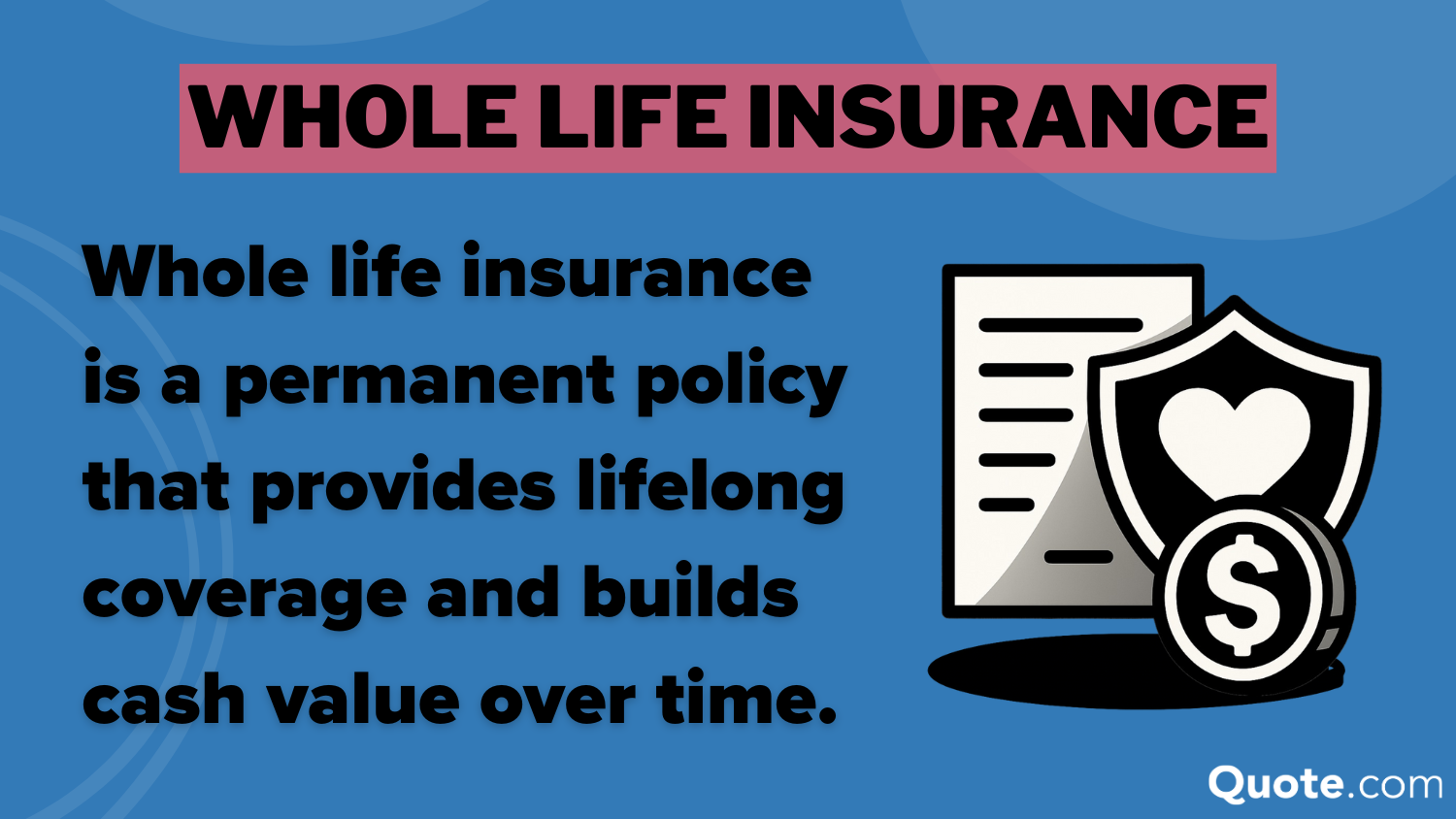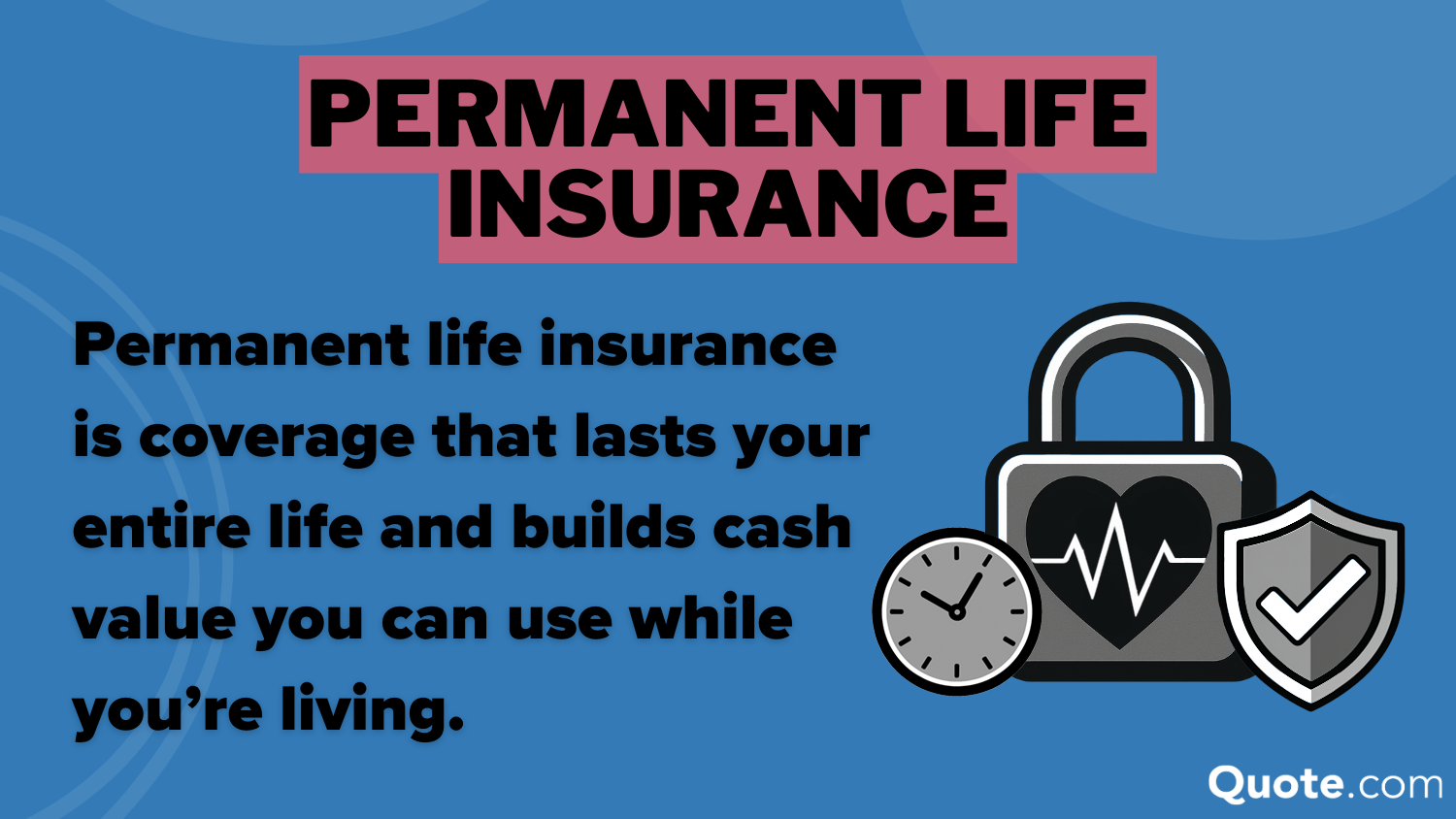Whole Life Insurance 2025 Guide
Whole life insurance is permanent coverage that lasts a lifetime as long as premiums are paid. The best whole life insurance rates are with Banner Life, starting at $75 a month for a $250,000 policy. Permanent policies also build cash value that can complement your investments, including retirement savings.
Read more Secured with SHA-256 Encryption




Table of Contents
Table of Contents


Licensed Insurance Agent
Jeff is a well-known speaker and expert in life insurance and financial planning. He has spoken at top insurance conferences around the U.S., including the InsuranceNewsNet Super Conference, the 8% Nation Insurance Wealth Conference, and the Digital Life Insurance Agent Mastermind. He has been featured and quoted in Nerdwallet, Bloomberg, Forbes, U.S. News & Money, USA Today, and other leading...
Jeff Root


Senior Director of Content
Sara Routhier, Senior Director of Content, has professional experience as an educator, SEO specialist, and content marketer. She has over 10 years of experience in the insurance industry. As a researcher, data nerd, writer, and editor, she strives to curate educational, enlightening articles that provide you with the must-know facts and best-kept secrets within the overwhelming world of insurance....
Sara Routhier


Licensed Insurance Agent
Heidi works with top-rated life insurance carriers to bring her clients the highest quality protection at the most competitive prices. She founded NoPhysicalTermLife.com, specializing in life insurance that doesn’t require a medical exam. Heidi is a regular contributor to several insurance websites, including FinanceBuzz.com, Insurist.com, and Forbes. As a parent herself, she understands the...
Heidi Mertlich
Updated November 2025
Whole life insurance is permanent coverage that lasts a lifetime as long as premiums are paid, ensuring a guaranteed payout to beneficiaries. It differs from term life insurance by offering tax-deferred cash value that can be borrowed against and fixed premiums that never increase.
- Whole life insurance provides lifetime coverage with a guaranteed death benefit
- Banner Life offers the lowest rates, starting at $75 a month for a $250,000 policy
- Whole life builds tax-deferred cash value that can be borrowed against
Rates start at $75 a month for a $250,000 policy, so it’s more expensive than term life insurance, but it provides better protection and an investment element that could benefit you depending on how much life insurance you need.
Whole Life Insurance Coverage Overview| Feature | Description |
|---|---|
| Death Benefit | Guaranteed payout to beneficiaries |
| Coverage Duration | Lifetime (as long as premiums are paid) |
| Premiums | Fixed / Level premiums throughout life |
| Cash Value Component | Yes, grows tax-deferred over time |
| Policy Loans | Allowed (loaned against cash value) |
| Dividends (if participating) | Possible, depending on insurer performance |
| Cost Compared to Term | Higher than term life insurance |
This whole life insurance guide explains how coverage works, what to expect from premiums, and the benefits and drawbacks of choosing this policy. Free instant life insurance quotes are just a click away. Enter your ZIP code to get started.
Whole Life Insurance Coverage Explained
Whole life insurance lasts your entire life as long as you keep paying your premiums. It guarantees a payout to your life insurance beneficiaries when you pass away and also builds cash value that grows over time.
Premiums stay the same for life, so you don’t have to worry about higher costs as you get older or if your health changes.
Some policies may also pay dividends, which can be used to lower your premiums, grow your cash value, or increase your payout.
Travis Thompson Licensed Insurance Agent
While it usually costs more than term life insurance, whole life gives you steady coverage and a financial benefit you can use while you’re alive.
Whole life insurance includes a cash value feature that works like a savings account inside your policy. It grows over time with interest you can borrow against or withdraw.
It grows tax-deferred, and you can borrow against it if you need extra money, but any unpaid loans will lower the payout your family receives.
Before buying a policy, you should know the differences between whole vs. term life insurance.
Free Life Insurance Comparison
Compare Quotes From Top Companies and Save
Secured with SHA-256 Encryption
The Cost of Whole Life Insurance
Whole life insurance premiums vary by the amount of coverage, and larger policies can become very costly. A $250,000 policy is the most common choice, with Banner Life offering the lowest rate at $75 per month. Higher coverage options such as $500,000 and $1 million are available, but they come with much higher monthly premiums (Read More: Cheapest Million-Dollar Life Insurance Policies).
Whole Life Insurance Monthly Rates by Policy Amount| Insurance Company | $250k | $500k | $1M |
|---|---|---|---|
| $175 | $375 | $740 | |
 | $75 | $365 | $720 |
| $190 | $495 | $970 | |
| $187 | $460 | $920 | |
| $186 | $510 | $990 | |
| $178 | $390 | $760 | |
| $181 | $545 | $1,060 | |
| $183 | $530 | $1,030 | |
| $184 | $430 | $860 | |
| $180 | $420 | $840 |
While Banner Life sets itself apart with the lowest entry-level rates, providers like Guardian and MassMutual appeal to policyholders seeking long-term value through strong cash growth and dividend potential. New York Life and Northwestern Mutual remain more expensive at higher policy amounts, but they are often chosen by families and individuals focused on estate planning and wealth transfer strategies.
The most popular whole life coverage levels are $100,000 and $250,000, chosen by 60% of policyholders according to recent data. Banner Life offers the most competitive entry-level rate, while Guardian and MassMutual trend higher but include strong cash value growth and dividend options. Learn more in our MassMutual Insurance review.
For large policies above $1 million, premiums nearly double compared to mid-range coverage, making them best suited for estate planning or wealth transfer needs. See how the average cost of life insurance changes by policy type and personal factors.
How Age & Gender Impact the Cost of Whole Life Insurance
Age and gender strongly affect the cost of whole life insurance. Women usually pay less than men because they live longer on average. At age 20, a woman pays about $150 a month for a $250,000 policy, while a man pays $170. By age 40, women pay $240 and men pay $270 for the same coverage.
The older you are when you buy, the more expensive it gets. At age 50, women pay $350 and men $400 each month. By age 70, rates rise sharply to $750 for women and $850 for men. This shows that the best way to save money is to buy whole life insurance at a younger age when premiums are lower. Learn how to get life insurance quotes to compare options and find the best rate.
How Health Impacts the Cost of Whole Life Insurance
Your health directly impacts what you’ll pay for whole life insurance. Applicants in excellent health qualify for the lowest monthly premiums, while those with ongoing health issues face higher costs. Because whole life coverage lasts a lifetime, insurers weigh health risks heavily when setting rates.
Whole Life Insurance Monthly Rates by Health Condition| Insurance Company | Excellent | Good | Average | Poor |
|---|---|---|---|---|
| $120 | $140 | $175 | $210 | |
 | $115 | $135 | $75 | $205 |
| $125 | $145 | $190 | $220 | |
| $118 | $138 | $187 | $215 | |
| $122 | $142 | $186 | $225 | |
| $119 | $139 | $178 | $212 | |
| $130 | $150 | $181 | $230 | |
| $128 | $148 | $183 | $228 | |
| $124 | $144 | $184 | $218 | |
| $121 | $141 | $180 | $214 |
Banner Life offers the lowest premium at $115 a month for excellent health, but the rate nearly doubles for applicants in poor health to $205 per month. New York Life shows one of the steepest jumps, from $130 in excellent health to $230 in poor health. Shop around with the best life insurance companies to compare quotes and find affordable coverage.
Northwestern and New York Life are the largest whole life insurance companies, with 24% and 22% of policies, respectively. MetLife and Prudential make up 19% and 18%, respectively, while MassMutual holds 17%. Together, these top five companies cover most of the whole life insurance market. However, if you compare whole life insurance quotes online before you buy, you may find better rates with a regional provider.
Weighing the Pros and Cons of Whole Life Insurance
Whole life insurance has several advantages that make it useful for many people. It gives lifetime coverage as long as you keep paying, so your family is always protected with a guaranteed payout. It also builds cash value that grows over time and can be borrowed if needed.
Whole Life Insurance: Pros and Cons| Pros | Cons |
|---|---|
| Lifetime coverage guaranteed | Higher premiums than term |
| Builds cash value over time | Slower cash growth early on |
| Fixed premiums | Less flexible compared to term |
| May pay dividends | Cost may not justify need for some |
| Can be used for estate planning | Cash value may reduce death benefit |
Premiums also stay the same each month, and some policies may pay dividends that add extra value. These features make it a good choice for long-term planning and leaving money behind for loved ones. There are also some disadvantages of whole life insurance to think about, such as premiums. It costs more than term life insurance, so it may not fit every budget.
Choose a whole life insurance coverage worth 7–10 times your yearly income to protect your family.
Brad Larson Licensed Insurance Agent
The cash value builds slowly at first, so it takes years before it grows into a large amount. It is also less flexible than term life, which works better for short-term needs. For some people, the higher cost may not match what they really need from life insurance.
Read More: How to Finance What Your Health Insurance Won’t Cover
How to File a Whole Life Insurance Claim
Filing a whole life insurance claim is not too hard if you know the steps. First, contact the insurance company soon after the policyholder passes away. They will tell you what forms you need to fill out and what documents are required. Having the death certificate and ID ready makes this part much faster.
How to File a Claim on Your Whole Life Insurance Policy| Step | Action | Description |
|---|---|---|
| #1 | Find the policy | Look for original or contact insurer |
| #2 | Notify insurer | Call and provide death info |
| #3 | Request claim forms | Ask for required paperwork |
| #4 | Gather documents | Death certificate, ID, forms |
| #5 | Submit claim | Send via mail or online |
| #6 | Settle cash value/loans | Loans may reduce payout |
| #7 | Receive payment | Lump sum or payout option |
After you send the forms and papers by mail or online, the company will review the claim. They will check that the policy is still active and see if any loans were taken from the cash value, since this can lower the final payment. Once everything is approved, the money is given to the beneficiary, either all at once or in another payout option the insurer allows. Compare the best auto insurance companies for claims handling today.
Free Life Insurance Comparison
Compare Quotes From Top Companies and Save
Secured with SHA-256 Encryption
Buying Whole Life Insurance Coverage
The most common reasons to buy life insurance often come down to protecting your family and covering expenses. Whole life insurance is important because it protects your family for your entire life. It gives a guaranteed payout to your beneficiaries as long as you pay the premiums, and it also builds cash value you can use if you ever need extra money.
Top 5 Reasons to Buy Whole Life Insurance| Purpose | Benefits |
|---|---|
| Estate Planning | Guarantees death benefit + cash for heirs |
| Business Succession Planning | Can fund buy-sell agreements |
| Wealth Transfer | Tax-advantaged inheritance tool |
| Long-Term Financial Security | Reliable coverage and forced savings |
| Loan Collateral or Emergency Fund | Access cash value when needed |
Whole life insurance offers steady coverage and lasting security, making it a strong choice for families who want lifelong protection. It can also help with bigger goals like planning your estate, passing on wealth, or even supporting a family business. While it does cost more than term life insurance, many people choose it for the peace of mind it brings.
Simplify your life insurance shopping by entering your ZIP code into our free quote comparison tool and find coverage that fits your budget and needs.

Frequently Asked Questions
What does whole life insurance mean?
The whole life insurance meaning is synonymous with permanent life insurance. It lasts your entire lifetime as long as premiums are paid, and guarantees a death benefit for your beneficiaries and builds cash value over time.
Who needs whole life insurance?
Whole life insurance is best for people who want lifetime coverage, need help with estate planning, or want to leave a guaranteed inheritance. It’s also useful for business owners and families who value cash value growth.
What are the disadvantages of whole life insurance?
The main disadvantages are higher premiums compared to term life insurance, slower cash value growth in the early years, and less flexibility if you only need short-term coverage. Enter your ZIP code into our free quote comparison tool to instantly compare life insurance quotes from trusted insurers near you.
What are the three types of whole life insurance?
The three main types of life insurance are fixed premiums, participating whole life that may pay dividends, and limited-pay whole life, where you finish paying within a set time but keep lifetime coverage.
Can I withdraw money from whole life insurance?
Yes. You can withdraw from the cash value of your policy, but doing so may reduce your death benefit. Some people choose to borrow against the cash value instead, which also needs to be repaid with interest.
How much a month is a $500,000 whole life insurance policy?
A $500,000 whole life insurance policy can cost anywhere from $350 to $550 per month on average. Your exact rate depends on age, gender, health, and the insurer.
Does whole life insurance expire?
No. Whole life insurance does not expire as long as premiums are paid. Unlike term life insurance, which ends after a set number of years, whole life offers lifetime protection.
How much life insurance do I need at age 55?
At age 55, the amount of life insurance you need depends on your financial goals. Many people choose coverage equal to 7–10 times their income, or enough to cover debts, retirement support for a spouse, and final expenses.
Read More: Single Premium Life Insurance
Why are people so against whole life insurance?
Some people dislike whole life insurance because it costs much more than term life, and the cash value grows slowly in the early years. Others feel the benefits don’t justify the higher price unless you need lifelong coverage.
What happens if I stop paying for whole life insurance?
If you stop paying premiums, your policy could lapse, and coverage may end. Some policies allow you to use the built-up cash value to keep the coverage going for a limited time, but this reduces the death benefit.
What happens to whole life insurance when I retire?
What is the cash value of a $10,000 whole life insurance policy?
Get a FREE Quote in Minutes
Insurance rates change constantly — we help you stay ahead by making it easy to compare top options and save.






